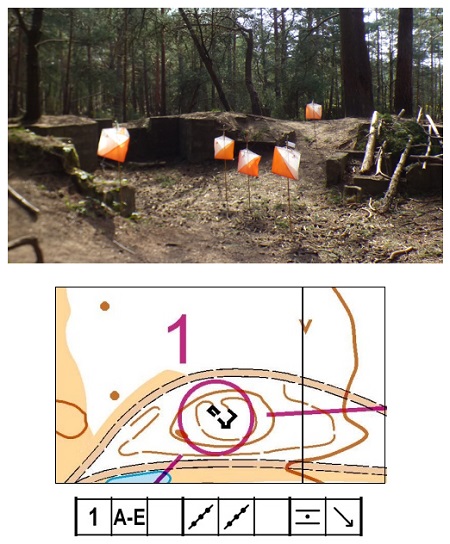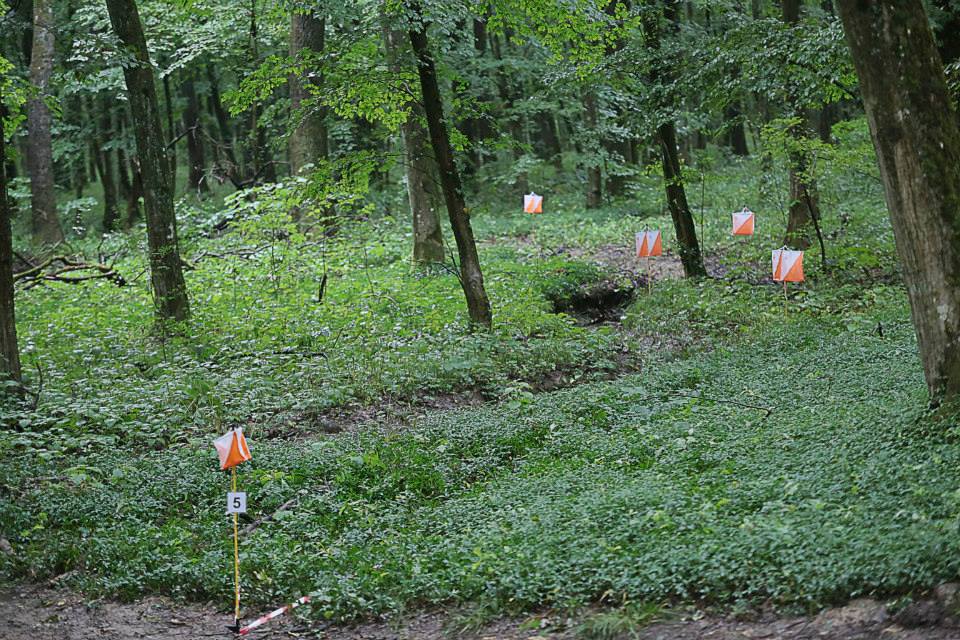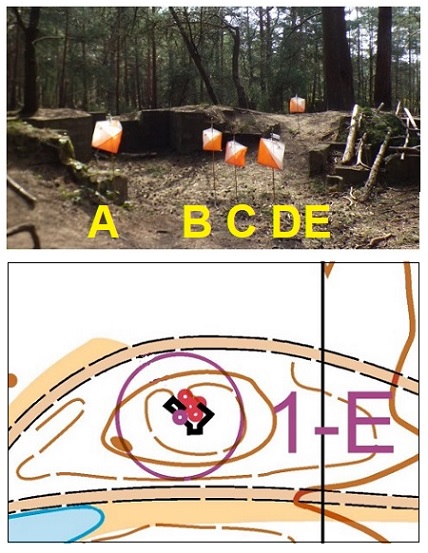

The two main alternative formats in TrailO are called 'PreO' and 'TempO'. Here we consider the PreO format. For the TempO version, see: Event formats - TempO
An example PreO challenge
The photo and map are from a PreO control at the 2022 British Championships. Which flag, if any, is where the centre of the circle is on the map? The control description below the map indicates that the flag should be 'between 2 walls'. The photo was taken looking south from the track north of the feature. The solution is given at the bottom of this page.

How does PreO differ from ‘standard’ orienteering?
PreO completely eliminates the element of speed over the ground, but makes the map interpretation element much harder. Depending on the level of difficulty, up to six control flags are hung at each site and only one will correspond exactly with the control description and control circle position. However, an additional possible answer is that 'None of the flags corresponds'. To designate the answer to be recorded, from a designated viewing point the visible flags are allocated letters from the left: A, B, C, etc. If a competitor considers that 'None of the flags corresponds', this is recorded as 'Z'.
Sites are chosen so that they can be seen from a wheelchair-navigable path or area, but they may be quite a distance into the forest or non-navigable terrain. The only special equipment needed is a compass. An escort can give the competitor physical help - pushing a chair, holding and orienting map and compass, even marking the control card with the decision according to the competitor's instructions. However, it is an important rule that escorts must not help in the decision-making process; they can give as much physical help as may be necessary, but must not offer advice or opinions to the competitor.
At international level there are separate O (Open) and P (Physically challenged) classes, but at most competitions able-bodied and disabled participants compete on equal terms.
So who is the winner if time does not matter?
The primary ranking is on how many of the total number of control sites are correctly identified. That is likely to leave several competitors with the same score, so there is a second element, based on time, to identify one or two controls, which acts as a tie-breaker.
But you just said speed did not matter!
Time over the ground does not matter; but at a 'timed control' the competitor is handed a 'clean' map with just one control circle and one description on it. The time to make the decision is recorded, not the time taken to get from A to B. The shorter the decision time, the higher the ranking against competitors with an equal number of correct scores.
What's all this about classes and levels of difficulty? You said there was no classification by disability.
Different classes cater for different levels of experience - you can usually decide for yourself which one to enter. Degree of disability has nothing to do with the different classes. In British events it is normal to have Elite and Standard classes, and sometimes there is also a Novice class.
Aren't the able-bodied at an advantage because they can look all around a control site, unlike anyone in a wheelchair?
No, it is a rule that no-one must leave the path (trail) to gain such an advantage. Provided the able-bodied (and the more adventurous wheelchair users) observe this rule, all compete equally. Obviously, all the control markers must be hung so that they can be seen by anyone in a seated position on the trail.
Provision for disabled participants
Surely very few forests have tracks adequate for a wheelchair?
On the contrary, you do not need smooth paths, and it can be much more fun for disabled participants if they do get 'off the beaten track' for a change. Even an 'out and back' single track, provided it has some good features visible from it, will do - though a loop is preferable. Extra 'pushers' can be stationed at steep sections; sometimes they use ropes and become 'pullers' instead!
Wouldn't people in wheelchairs like to race between control sites?
Only a small proportion of people in wheelchairs have full strength in their upper bodies permitting them to race, and yes, racing wheelchair O events do exist. However, the multi-choice form of TrailO described here has been developed as a means of allowing anyone - in an electric, self-propelled or pushed wheelchair, with a walking difficulty, on crutches, even on a bicycle (which some kinds of disability are best served by), or any able-bodied person, all to compete in the same event on the same terms.
What about people with mental disabilities?
Research continues on the best way of providing orienteering for those with mental disabilities; a 'string' course similar to those provided for young children at conventional O events may be suitable, and some will be able to cope with TrailO novice courses which often have just two markers at each control site.
And what about the visually impaired?
Much more work needs to be done in this sector, but one approach is to draw 'maps' on special paper which swells where marked, when it is baked. Many 'registered blind' people have some residual vision, and blown-up colour photocopies of maps may be readable.
(The original article, written by Don Braggins, was published in Challenge magazine. It has been adapted for use on this website.)

PreO control site
Solution to the challenge at the top of the page

Remember that the photo is taken from the northern track looking south. On the solution map the flags are marked with the small circles. The correct one is the purple circle which is the 'E' (or Echo) flag.